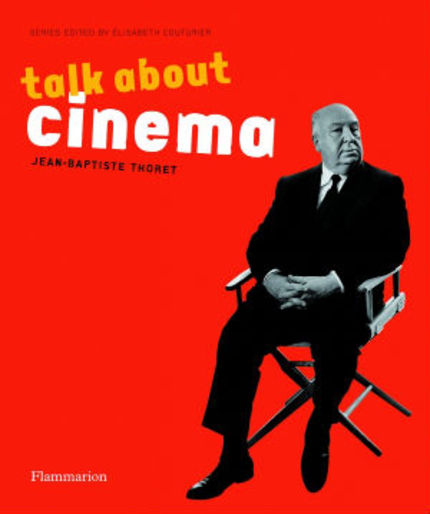Book Review: TALK ABOUT CINEMA by Jean-Baptiste Thoret is Too Fun to be This Smart

That's not to say that some of these books aren't thoughtful and well-written, even quite insightful. It's just that there's a sameness to many of them that borders on the formulaic. Readers are treated largely to the long-acknowledged classics and landmarks of world cinema, with any freshness usually coming in only the final chapter or two, or perhaps via a token image of someone like Audrey Tatou on the front cover. Those are the places where more recent cinema gets a nod, and often tentatively at that, as if the jury's still out on Lynch or Herzog or Assayas, or any number of other important contemporary filmmakers.
All of this represents a problem that Talk About Cinema, written by critic, blogger, and historian Jean-Baptiste Thoret, corrects... often spectacularly. The result is a book that not merely honors the past -- the Oscars telecast, "classic film" cable stations and university film departments around the globe already do that -- but demonstrates its vital, ongoing connection to the living, breathing present-tense of the art form.
Typically a survey-style tome like this will front-end all of the canon's usual suspects, doing so in the context of either a chronological or generic organization. Thoret thoroughly abandons this approach. Yes, Hitchcock, undeniably a safe bet, is on the cover. But then flip that cover over and, bam, before you even reach the title page, there's a full-page still from the ending of Oldboy. Flip the page again and we get Gong Li from 2006 opposite Pixar's Monsters, Inc,. Then flip it again and we get a shot of Polanski directing and an extreme close-up of Arnold in T3. Flip once more and we get Karan Johar's My Name is Khan and Antichrist. See what I'm getting at? There's no Chaplin or Lang or Kurosawa, despite the wonderful images their films could undeniably provide.
The chapter on "20 Seminal Films" would be where you'd expect to see a tired "hall of fame"-style enshrinement of such directors' work. But here "seminal" isn't just a code word for "most important": readers really do get a sense of how a particular film has left lasting ripples by means of its content, theme, technique, tone, or generic elements. Thus we have The Red Shoes side by side not only with Black Swan, but also with Suspiria. Freaks is juxtaposed with Stuck on You... and Buñuel's Viridiana... and Korine's Gummo, among others. But Thoret gets still more creative than this. One of those twenty films is Zapruder's JFK assassination footage, which is paired with De Palma and, most strikingly, The Deer Hunter. What's more, television series such as Patrick McGoohan's The Prisoner and Rod Serling's The Twilight Zone are also credited with being seminal "films," which, culturally, they are. Similarly, in a section on "Firsts" -- which might seem like a lazy way to do history but isn't in this case -- Thoret doesn't simply list famous accomplishments, but draws connections across time and genre. For example, we learn that the first slowmo was developed by August Muger for military purposes back in 1904, and then get the idea updated via Wong Kar-Wai, Tsui Hark (The Blade is termed his "masterpiece") and of, course, The Matrix. Likewise, the page about the first zoom cites the Clara Bow vehicle It in 1927 -- but is illustrated with a quartet of images from Mario Bava's Hatchet for the Honeymoon.
Wait, do you see what's happening here? I'm just starting to list "cool stuff" and neat ideas, and writing less of a real review. I guess the fact that the book mentions so many ScreenAnarchy-tastic films makes me eager to share them. Oh, and on top of this fun content is the book's inviting design. I'm not sure of the degree to which it mimics that of the other titles in Flammarion's "Talk About" series, but if it does, I'll probably want to check them out. Using large-print decks, entire passages set off in boldface, and a generous supply of rarely-less-than-gorgeous stills, Talk About Cinema is terrifically readable even apart from its clean, quick-moving prose. In fact, it's a lot like a really good series of Web articles with accompanying photo galleries yet still boasts the scope and density of a well-researched book.
Are there certain things in it that rub me the wrong way? Sure -- the elevated status given to Michael Mann's Miami Vice, for one. But any film book worth its salt will provoke those sorts of responses. Are there outright errors? Yep, those too, but they're minor and actually seem the result of poor editing more than anything else. In the analysis of Malick's The New World we get a still that's clearly Adrien Brody from The Thin Red Line. In the section on "The Aardman Style" we read that "A Close Shave signaled the end of the adventures of Wallace and his dog Gromit" -- as if the feature-length Curse of the Were-Rabbit had never been made.
Kind of petty on my part, right? Well, that's the point. Way more engaging and uplifting than I expected it to be, Talk About Cinema makes its subject matter so vivid that you'll be tempted not to watch any new movies for a while. Instead, you may want to use Thoret's book to happily project a thousand old favorites in your head.

Do you feel this content is inappropriate or infringes upon your rights? Click here to report it, or see our DMCA policy.






